Lickey Incline
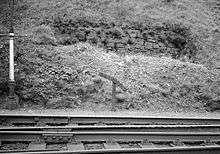
The Lickey Incline, south of Birmingham, is the steepest sustained main-line railway incline in Great Britain. The climb is a gradient of 1 in 37.7 (2.65% or 26.5‰ or 1.52°) for a continuous distance of two miles (3.2 km). It is located on the Cross Country Route between Barnt Green and Bromsgrove stations in Worcestershire.
Some trains still require the assistance of banking locomotives to ensure that the train reaches the top.
History and geography
It is part of the Birmingham and Gloucester Railway, surveyed by Isambard Kingdom Brunel in 1832, who suggested a route well to the east. William Moorsom was asked to take over, with his remuneration linked to the savings he achieved. At the time, most railways were for difficult terrain between canals, and the use of cable assistance would not have seemed unreasonable. (When Brunel, for instance, first surveyed the GWR, he planned to use cable assistance in the Box Tunnel.)
The climb is just over 2 miles (3.2 km), at an average gradient of 1 in 37.7 (2.65%), between Bromsgrove and Blackwell (near Barnt Green). It is on the railway line between Birmingham and Gloucester (grid reference SO985710). The Lickey Incline is the steepest sustained adhesion-worked gradient on a British standard gauge railway. It climbs into Birmingham from the south over the Bunter geological formation (one or two exposures are visible from the track-side), and passes about 1 1⁄2 miles (2.4 km) away from the Lickey Hills, a well-known local beauty spot.
Between 2015 and 2016, the incline is being electrified overhead as part of the scheme to extend electric Cross-City Line trains to a resited Bromsgrove railway station by 2017.

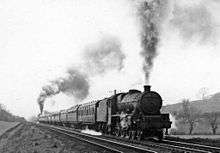

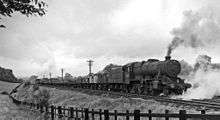
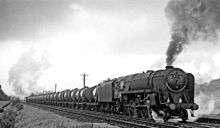
Bankers
Steam locomotives
To assist trains up the incline and in some cases to provide additional braking, particularly to unfitted freights, specialised banking engines were kept at Bromsgrove shed at the foot of the incline.
The first locomotives were American Norris 4-2-0s, English manufacturers having declined to supply. The railway acquired 26 of them, of which the last nine were built in England, three by Benjamin Hick and Sons and six by Nasmyth, Gaskell and Company The last one was withdrawn in 1856.
Around 1845 a large 0-6-0ST, the Great Britain was built in Bromsgrove Works.
1377 Class 1Fs, and later 2441 Class 0-6-0Ts were used on the route.
In 1919 the specialised 0-10-0 No. 2290 "Big Bertha" was introduced to complement the existing 0-6-0Ts. "Big Bertha" was withdrawn in 1956 and replaced by BR standard class 9F No. 92079, which acquired Big Bertha's headlight.
The LNER Class U1 Garratt was also tried out unsuccessfully in 1949–1950 and again in 1955. On one occasion it was banking a train hauled by LMS Garratt No. 47972 which stalled on the bank and was rescued by "Big Bertha",[1] resulting in the formation of a train with nineteen driving axles.
The Lickey was transferred to the Western Region in 1958 and the 3F tanks were replaced by GWR 9400 Class pannier tanks and 92079 was replaced by classmate 92230, which did not acquire the headlight.
Diesel locomotives
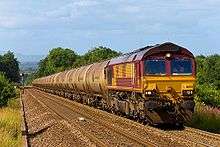
Steam was replaced by Class 37s, working in pairs. Other classes that appeared include Hymeks. The Hymeks allocated to Lickey banking duties were modified so that the lowest transmission ratio was inoperative, despite the requirement for high tractive effort. The reason for this modification was that the typical speed of a train ascending the bank was approximately that at which the transmission would change between first and second gear, and so it tended to "hunt" between the two. The repeated gear changes under full power caused excessive wear and damage, and the simplest way to avoid the problem was to lock first gear out of action, so the locomotives used only second gear and upwards.[2]
First-generation diesel multiple units were somewhat underpowered and climbed the bank often at little above walking pace, especially as they aged; it was not unknown for them to need to be rescued by a banker. The more powerful modern DMUs negotiate the line with little speed reduction, though there remain rules that at least half of the engines of a Class 220 or 221 must be working in order to ascend.[3] Many current freight trains still need to be banked however and DB Cargo UK uses five dedicated Class 66 Nos 66055-059 to do this.
Operation in steam days[4]
The bankers would stand in a siding on the up side to the south. The load of each train would be telegraphed from Cheltenham.
If the driver decided he needed more bankers than the table provided for him, he would whistle approaching Stoke Works signal box: a short whistle, pause, and a number of shorts indicating the number of bankers he wanted. (The 0-10-0 counted as two).
He stopped at a marker fifteen yards (14 m) to the rear of Bromsgrove Station up home signal, or further up if necessary to clear the crossover by which the bankers moved on to the back of his train. They were not coupled to his train or to each other. When he was in position each banker gave two crow whistles,[5] and the train driver gave two crows in reply. Then he gave one long whistle and all of them opened their regulators.
At the top the bankers kept pushing through Blackwell station and then shut off in turn, keeping well apart, then crossed over to the down line and closed up ready to return.
To speed things up at busy times, Blackwell down advance starter signal had a calling-on arm which applied only to the bankers accepting them downhill while the station was still occupied.
Descending trains were never accepted unless the line was clear as far as Bromsgrove South, and were strictly required to slow to 10 mph (16.1 km/h) at the top and not exceed 27 mph (43.5 km/h) on the way down. Loose-coupled freight trains had to stop at the top to apply wagon brakes and not exceed 11 mph (17.7 km/h).
References
- ↑
- ↑ Lewis, JK. The Western's Hydraulics. ISBN 978-1-901945-54-6.
- ↑ Network Rail (2006-08-26). Western Route Sectional Appendix. Module GW1. p. 63. NR30018/02.
- ↑ Austin, S., (1998) Portrait of the Pines Express, Ian Allan Publishing
- ↑ A "crow whistle" was one long and one short. With modern diesels it is high then low.
Further reading
- Casserley, H.C. (1990) [1976]. The Lickey Incline (2nd ed.). The Oakwood Press. ISBN 9780853613176. OCLC 2525676.
- Smith, Donald J.M.; Harrison, Derek (1990). Over the Lickey!. Peter Watts. ISBN 9780906025710. OCLC 655869983.
- Wallace, Pat (2014). Life on the Lickey: 1943-1986. Brewin Books. ISBN 9781858585239. OCLC 884398031.
External links
| Wikimedia Commons has media related to Lickey Incline. |
- www.lickeyincline.co.uk – Lickey Incline Preserved Rail Resources
- - Lickey Archive Photobook – Sister site to lickeyincline.co.uk exclusively for photographs from all eras
Coordinates: 52°20′13″N 2°01′24″W / 52.33708°N 2.02344°W